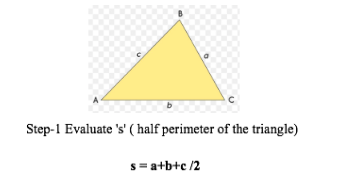Learn Class 11 Math - Heron’s Formula
A Greek mathematician 'Hero' of Alexandria discovered Heron's formula also called (Hero's formula) around 2000 years ago.
If you want to calculate the area of a triangle firstly you need to know the lengths of all three boundaries, then onwards you can calculate the area using the heron's formula.
For calculating the area of a right angle triangle we use simply the height and base formula. But for equilateral, isosceles, and scalene triangles we need to use Heron's formula.
Consider the three sides of a triangle as a, b and c. There are two steps to follow for finding the area of a triangle.

Now evaluate the Area
A = √s (s-a)(s-b) (s-c)
The formula can as well as be written as:
A=¼ √2(a²b²+a²c²+b²c²)-(a⁴+b⁴+c⁴)
Application of Formula
Evaluate the area of a triangle with lengths 2,3, and 5 respectively.
Here given that a= 3, b=4 and c=5
Step 1
S = a+b+c/2
S = 3+4+5/2
S = 6
Step 2
A= √s (s-a) (s-b) (s-c)
= √6 (6-3) (6-4) (6-5)
= √6×3×2×1
= √36
= 6